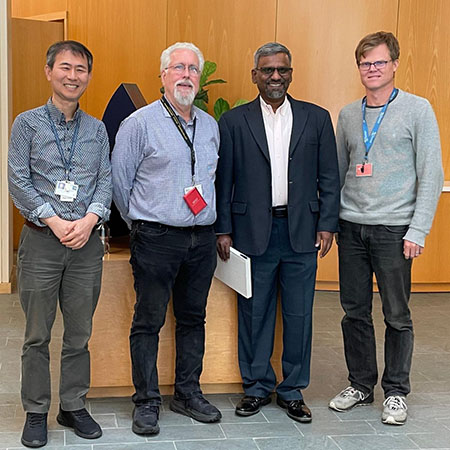The Bruce Hasegawa Memorial Lecture
This annual lecture honors the legacy of Dr. Bruce Hasegawa: his pioneering research accomplishments,
his ability to educate and inspire those he taught and mentored, and his generosity towards others.

Past Bruce Hasegawa Honorary Lecturers
- 2024: Srinivasan Vedantham, PhD, FAAP, University of Arizona
- 2022/23: Paul E. Kinahan, PhD, FIEEE, FAAPM, FSNMMI, FAIBME, University of Washington
- 2021: Frederik J. Beekman, PhD, Delft University of Technology, Netherlands
- 2019: Kim Butts Pauly, PhD, Stanford University, California
- 2018: James G. Pipe, PhD, Mayo Clinic, Rochester, Minnesota
- 2016/17: David William Townsend, PhD, A*STAR-NUS Clinical Imaging Research Centre, National University of Singapore
- 2015: Matthew A. Bernstein, PhD, Mayo Clinic, Rochester, Minnesota
- 2014: Debiao Li, PhD Biomedical Imaging Research Institute, Cedars-Sinai, Los Angeles, California
- 2013: Lawrence L. Wald, PhD, Harvard University, Boston, Massachusetts
- 2012: Norbert J. Pelc, PhD, Stanford University, California
- 2011: Simon R. Cherry, PhD, University of California, Davis
- 2010: Benjamin M.W. Tsui, PhD, Johns Hopkins University, Baltimore, Maryland
- 2009: Charles A. Mistretta, PhD, University of Wisconsin, Madison
About Bruce Hasegawa, PhD
 On May 22, 2008, the medical imaging community lost a brilliant investigator, an excellent educator, a devoted mentor, and above all a true friend. Bruce H. Hasegawa, Ph.D. died suddenly of a stroke at the age of 56. During his short life, Bruce imparted a tremendous legacy that would not only touch the lives of many colleagues but also unknowingly impact the lives of many patients who would come to benefit from Bruce’s superb research accomplishments.
On May 22, 2008, the medical imaging community lost a brilliant investigator, an excellent educator, a devoted mentor, and above all a true friend. Bruce H. Hasegawa, Ph.D. died suddenly of a stroke at the age of 56. During his short life, Bruce imparted a tremendous legacy that would not only touch the lives of many colleagues but also unknowingly impact the lives of many patients who would come to benefit from Bruce’s superb research accomplishments.
Bruce was born on June 21, 1951 and grew up on an almond farm on the outskirts of Fresno, California. He had a diverse educational background in basic sciences with multiple degrees in Mathematics, Physics, Radiology Sciences, and Medical Physics. He earned his Ph.D. in Medical Physics at University of Wisconsin, Madison in 1984 under the mentorship of Charles Mistretta. Bruce joined the University of California, San Francisco (UCSF) Department of Radiology in 1986 and rose through the academic ranks to the position of Professor in Residence and Director of the Physics Research laboratory. Bruce was dedicated to improving the Medical Physics curriculum at UCSF to better prepare students for the biomedical imaging field. In 1997, he joined the Nuclear Engineering Department at the University of California, Berkeley (UCB) and was deeply involved through his teaching and research with the joint UCSF/UCB Graduate Program in Bioengineering, serving as Co-Chair for several years.
His distinguished research career at UCSF was highlighted by his pioneering work combining SPECT functional imaging with CT anatomical imaging to produce the first combined dual-modality imaging system, SPECT/CT. His research contributions included x-ray imaging for medical diagnostics, development of nuclear medicine imaging instrumentations, tomographic reconstruction algorithms for radionuclide imaging data, small animal SPECT/CT imaging, and many other areas in medical physics and bioengineering.
Bruce was also a prolific writer during his career, publishing widely popular papers mostly in dual-modality imaging. His textbook entitled “The Physics of Medical X-Ray Imaging,” subtitled “The Photon and Me: How I saw the Light” is still regarded among the classic books in medical imaging literature.
He was a consummate teacher and mentor to a generation of graduate students and postdoctoral fellows. He was unfailingly generous with his time and attention, often putting the interest of others before his own. Behind his brilliant mind lay a simple man who appreciated life’s simple pleasures. Bruce was genuine, kind, generous, humble, sensitive and thoughtful. His untimely death touched many of his professional colleagues, friends and students worldwide.
Adapted from an obituary by Youngho Seo, Ph.D.1 and Grant T. Gullberg, Ph.D.1,2
1 Department of Radiology and Biomedical Imaging, University of California, San
Francisco
2 Ernest Orlando Lawrence Berkeley National Laboratory
